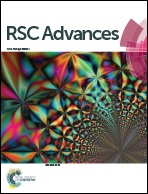Synthesis of vertical aligned TiO2@polyaniline core–shell nanorods for high-performance supercapacitors†
Abstract
Ordered arrays of a TiO2@polyaniline core–shell nanocomposite exhibiting specific capacitance as high as 820 F g−1 at 1 A g−1 were prepared by the combination of hydrothermal and in situ chemical polymerization methods. The specific capacitance retention of the nanocomposite is over 85% after 1000 charge and discharge cycles at a current density of 10 A g−1, suggesting good cycling stability.


 Please wait while we load your content...
Please wait while we load your content...